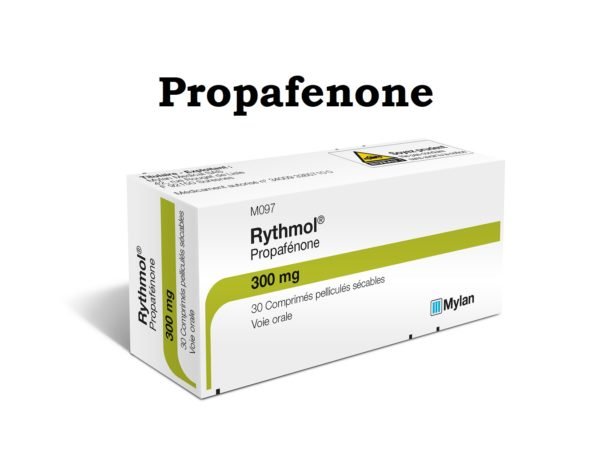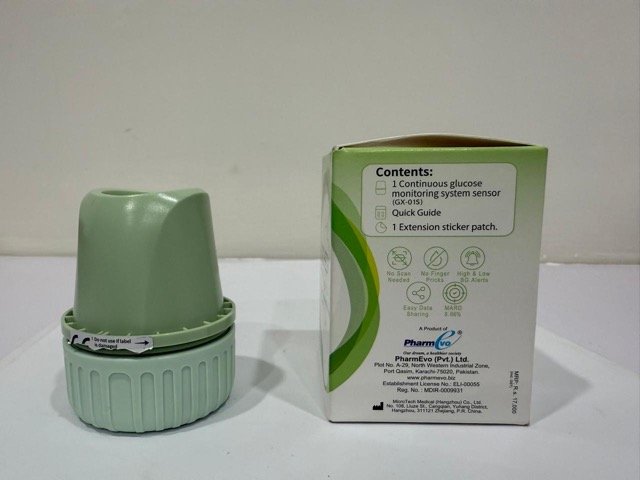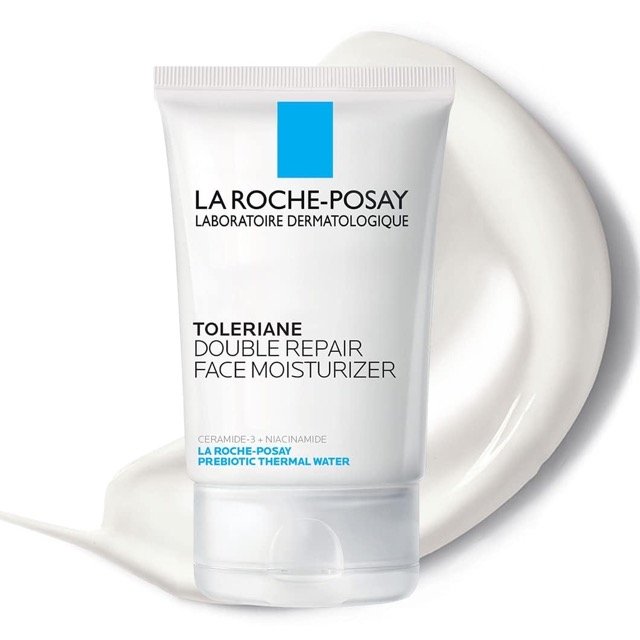Propafenone available by the brand name of Rythmol is a class 1C antiarrhythmic drug that has membrane-stabilizing and anesthetic properties.
Indications of propafenone:
- It is indicated for the treatment of life-threatening ventricular arrhythmias, to prolong the time to recurrence of paroxysmal atrial fibrillation/ flutter or paroxysmal supraventricular tachycardia in patients with disabling symptoms without structural heart disease
-
Extended-release capsule:
- It is useful for prolonging the time to recurrence of symptomatic atrial fibrillation in patients without structural heart disease.
-
Off Label Use of Propafenone in Adults:
- Paroxysmal atrial fibrillation (pharmacological cardioversion);
- Ventricular premature beats
Propafenone dose in adults:
Note:
Dose reduction is required for patients with a significant widening of QRS complex or second- or third-degree AV block.
Propafenone dose in the treatment of Atrial fibrillation to prevent recurrence:
-
Extended-release capsule:
- Initial: 225 mg per oral every 12 hours;
- The dosage increase may be made at a minimum of 5-day intervals;
- The dose may be increased to 325 mg every 12 hours;
- if a further increase is necessary, the dose may be increased to 425 mg every 12 hours.
-
Immediate-release tablet:
- Initial: 150 mg per oral every 8 hours;
- Dosage increase may be made at a minimum of 3- to 4-day intervals, may increase to 225 mg every 8 hours;
- If a further increase is necessary, may increase to 300 mg every 8 hours.
Propafenone dose in the treatment of Paroxysmal supraventricular tachycardia to prevent recurrence:
-
Immediate-release tablet:
- Initial: 150 mg per oral every 8 hours;
- The dosage may be increased at a minimum of 3- to 4-day intervals to 225 mg every 8 hours;
- If a further increase is necessary, may increase to 300 mg every 8 hours.
-
Alternate recommendations:
-
Immediate-release tablet:
- Initial: 150 mg per oral every 8 hours;
- The maximum maintenance dose: 300 mg every 8 hours.
-
Extended-release capsule:
- Initial: 225 mg per oral every 12 hours
- maximum maintenance dose: 425 mg every 12 hours.
-
Propafenone (Rythmol) dose for the pharmacologic cardioversion of Paroxysmal atrial fibrillation:
Note:
- May be used on an outpatient basis (“Pill-in-the-pocket”).
- The patient must be taking an AV nodal-blocking agent (eg, Beta-blocker, non-dihydropyridine calcium channel blocker) before starting antiarrhythmic.
-
Immediate-release tablet:
- weight <70 kg:
- 450 mg
- weight ≥70 kg:
- 600 mg
- May not repeat in ≤24 hours
- weight <70 kg:
Propafenone (Rythmol) dose in the treatment of Ventricular arrhythmia:
-
Immediate-release tablet:
- 150 mg per oral every 8 hours; dosage increase may be made at a minimum of 3- to 4-day intervals, may increase to 225 mg every 8 hours;
- If a further increase is necessary, may increase to 300 mg every 8 hours.
-
Extended-release capsule (off- label dose):
- 225 to 425 mg per oral every 12 hours.
Propafenone (Rythmol) dose in the treatment of Ventricular premature beats:
-
Immediate-release tablet:
- 150 to 300 mg per oral every 8 hours
-
Extended-release capsule:
- 225 to 425 mg per oral every 12 hours
Dose in Children:
The safety and efficacy of the drug in children has not been established.
Pregnancy Risk Category: C
- The placenta is crossed by propafenone and 5-hydroxypropafenone, and they can be detected in the infant.
- It should not be administered in any way and should be avoided during the first trimester.
- For supraventricular tachycardia symptomatic, propafenone may be administered to pregnant women.
- It is also helpful in preventing supraventricular tachycardia in patients with Wolff-Parkinson-White syndrome.
- Propafenone should not be used as a first-line treatment. It is only recommended to treat arrhythmias in cases where other medications are not available.
- It can lead to a reversible impairment in spermatogenesis for males.
Propafenone use during breastfeeding:
- Breast milk contains propafenone as well as the 5-hydroxypropafenone metabolism.
- According to the case report, the relative infant dose (RID), of propafenone was 1% of weight-adjusted mother dose.
- When the relative infant dose for a medication is less than 10%, breastfeeding is permitted.
- Milk concentrations were 32 ng/mL (propafenone) and 47 ng/mL (5hydroxypropafenone).
- Based on actual maternal weight, one author calculated that the RID was 0.03%. Another author estimated it to be 0.1%.
- The milk was sipped at intervals of 1 to 12 hours following the last dose, regardless of postpartum age.
- According to the manufacturer breastfeeding during therapy is a decision that should be made after considering the risks and benefits to the baby as well as the benefits to the mother.
Dose adjustment in renal disease:
50% of propafenone metabolites are excreted in the urine, however there are no dosage adjustments provided in the manufacturer's labeling
Hemodialysis/CVVH:
- Minimally dialyzable , supplemental dose not necessary
Dose adjustment in liver disease:
There are no dosage adjustment provided in the manufacturer’s labeling; however, dosage reduction is necesssary as drug undergoes hepatic metabolism. In patients with mild to moderate liver impairment, the following dosing recommendations have been made:
- Initial: 150 mg once daily; if necessary, the dose may be increased by 150 mg/day in divided doses (eg, b.i.d or t.i.d) at a minimum of 4-day intervals up to a maximum of 300 mg every 12 hours.
Common Side Effects of Propafenone:
-
Central Nervous System:
- Unusual Taste
- Dizziness
-
Gastrointestinal:
- Nausea
- Vomiting
Side Effects Of Propafenone Include:
-
Cardiovascular:
- Cardiac Arrhythmia
- Angina Pectoris
- Cardiac Failure
- First Degree Atrioventricular Block
- Palpitations
- Ventricular Tachycardia
- Bradycardia
- Chest Pain
- Widened QRS Complex On ECG
- Syncope
- Ventricular Premature Contractions
- Atrial Fibrillation
- Bundle Branch Block
- Edema
- Cardiac Conduction Delay
- Hypotension
-
Central Nervous System:
- Fatigue
- Headache
- Ataxia
- Insomnia
- Anxiety
- Drowsiness
-
Dermatologic:
- Skin Rash
- Diaphoresis
-
Gastrointestinal:
- Constipation
- Diarrhea
- Dyspepsia
- Abdominal Pain
- Anorexia
- Xerostomia
- Flatulence
-
Neuromuscular & Skeletal:
- Weakness
- Arthralgia
- Tremor
-
Ophthalmic:
- Blurred Vision
-
Respiratory:
- Dyspnea
Contraindications to Propafenone:
- Hypersensitivity to propafenone and any component of the formulation
- Cardiac failure
- Cardiogenic shock
- Bradycardia/ severe hypertension
- COPD severe
- Severe electrolyte imbalance
- A, A.V, and intraventricular disorders in impulse generation or conduction.
- Liver impairment severe
- Myasthenia gravis
- Concurrent use of ritonavir
Warnings and precautions
-
Agranulocytosis
- Sometimes, granulocytosis may occur. It returns to normal within 2 weeks after therapy is stopped.
-
CNS effects
- Propafenone can cause blurred vision, dizziness, fatigue and dizziness. Patients should be cautious about driving or operating machinery.
-
Conduction disturbances:
- It can lead to prolonged PR, longer QRS duration, or slow atrioventricular Conduction, leading to first-degree AV block.
-
Titers of elevated antinuclear antibodies
- Positive antinuclear antibodies (ANA) were detected in some patients who received propafenone. However, not all of these cases resulted in drug-induced Lupus Erythematosus.
- The decrease in titers is seen regardless of discontinuation of therapy. However, discontinuation is required for patients who are symptomatic and have positive ANA titers.
-
Hepatotoxicity:
- Hepatocellular injury, cholestasis and other causes of life-threatening liver abnormalities can lead to serious consequences.
-
Proarrhythmic effects
- Propafenone has been shown to prolong QT, ventricular fibrillation and asystole.
- To prevent QT prolongation, monitoring and dose adjustment are essential.
-
Brugada syndrome:
- Brugada Syndrome may be unmaskable by Propafenone.
- ECG should be performed after treatment initiation. Therapy should be stopped in Brugada Syndrome.
-
Electrolyte imbalance:
- Patients with electrolyte abnormalities not corrected are advised to avoid use.
- It is important to correct electrolyte imbalances, especially hypokalemia and hypomagnesemia, before treatment.
-
Heart failure (HF):
- Propafenone can cause heart failure so it is best to avoid it.
-
Hepatic impairment
- Patients with hepatic impairment should be cautious.
-
Myasthenia gravis:
- Patients with myasthenia Gravis should be cautious. It may worsen the condition.
-
Pulmonary disease
- Patients with obstructive pulmonary disease can receive propafenone without bronchospasm.
- However, severe obstructive pulmonary disease is where it is contraindicated.
-
Renal impairment
- Patients with impaired renal function should be cautious.
Propafenone: Drug Interaction
|
Antihepaciviral Combination Products |
May increase the serum concentration of Propafenone. Management: Canadian labeling recommends avoiding this combination. |
|
ARIPiprazole |
CYP2D6 Inhibitors (Weak) may increase the serum concentration of ARIPiprazole. Management: Monitor for increased aripiprazole pharmacologic effects. Aripiprazole dose adjustments may or may not be required based on concomitant therapy and/or indication. Consult full interaction monograph for specific recommendations. |
|
Beta-Blockers |
|
|
Bradycardia-Causing Agents |
May enhance the bradycardic effect of other Bradycardia-Causing Agents. |
|
Brentuximab Vedotin |
P-glycoprotein/ABCB1 Inhibitors may increase the serum concentration of Brentuximab Vedotin. Specifically, concentrations of the active monomethyl auristatin E (MMAE) component may be increased. |
|
Bretylium |
May enhance the bradycardic effect of Bradycardia-Causing Agents. Bretylium may also enhance atrioventricular (AV) blockade in patients receiving AV blocking agents. |
|
Cardiac Glycosides |
Propafenone may increase the serum concentration of Cardiac Glycosides. |
|
Celiprolol |
P-glycoprotein/ABCB1 Inhibitors may increase the serum concentration of Celiprolol. |
|
Cimetidine |
May increase the serum concentration of Propafenone. |
|
CloBAZam |
May increase the serum concentration of CYP2D6 Substrates (High risk with Inhibitors). |
|
Cobicistat |
May increase the serum concentration of CYP2D6 Substrates (High risk with Inhibitors). |
|
CYP2D6 Inhibitors (Moderate) |
May decrease the metabolism of CYP2D6 Substrates (High risk with Inhibitors). |
|
CYP2D6 Inhibitors (Moderate) |
May increase the serum concentration of Propafenone. Management: Drugs listed as exceptions to this monograph are discussed in further detail in separate drug interaction monographs. Exceptions: Thioridazine. |
|
CYP3A4 Inducers (Strong) |
May decrease the serum concentration of Propafenone. |
|
CYP3A4 Inhibitors (Moderate) |
May increase the serum concentration of Propafenone. Management: Drugs listed as exceptions to this monograph are discussed in further detail in separate drug interaction monographs. Exceptions: Crizotinib; Erythromycin (Systemic); Fluconazole; Nilotinib; Ribociclib. |
|
CYP3A4 Inhibitors (Strong) |
May increase the serum concentration of Propafenone. Management: Drugs listed as exceptions to this monograph are discussed in further detail in separate drug interaction monographs. Exceptions: Clarithromycin; Saquinavir; Voriconazole. |
|
Darunavir |
May increase the serum concentration of CYP2D6 Substrates (High risk with Inhibitors). |
|
Etravirine |
May decrease the serum concentration of Propafenone. |
|
Everolimus |
P-glycoprotein/ABCB1 Inhibitors may increase the serum concentration of Everolimus. |
|
FLUoxetine |
Propafenone may enhance the QTc-prolonging effect of FLUoxetine. FLUoxetine may increase the serum concentration of Propafenone. |
|
FluvoxaMINE |
May increase the serum concentration of Propafenone. |
|
Haloperidol |
QT-prolonging Class IC Antiarrhythmics (Moderate Risk) may enhance the QTcprolonging effect of Haloperidol. Management: Monitor for QTc interval prolongation and ventricular arrhythmias when these agents are combined. Patients with additional risk factors for QTc prolongation may be at even higher risk. |
|
Imatinib |
May increase the serum concentration of CYP2D6 Substrates (High risk with Inhibitors). |
|
Ivabradine |
Bradycardia-Causing Agents may enhance the bradycardic effect of Ivabradine. |
|
Lacosamide |
Bradycardia-Causing Agents may enhance the AV-blocking effect of Lacosamide. |
|
Lacosamide |
QT-prolonging Class IC Antiarrhythmics (Moderate Risk) may enhance the adverse/toxic effect of Lacosamide. Specifically the risk for bradycardia, ventricular tachyarrhythmias, or a prolonged PR interval may be increased. |
|
Larotrectinib |
P-glycoprotein/ABCB1 Inhibitors may increase the serum concentration of Larotrectinib. |
|
Lumefantrine |
May increase the serum concentration of CYP2D6 Substrates (High risk with Inhibitors). |
|
Midodrine |
May enhance the bradycardic effect of Bradycardia-Causing Agents. |
|
Mirabegron |
May increase the serum concentration of Propafenone. Management: Monitor clinical response to propafenone closely. Dose adjustment may be necessary. Canadian mirabegron labeling recommends restricting the maximum adult mirabegron dose to 25 mg/day in patients receiving propafenone. |
|
Naldemedine |
P-glycoprotein/ABCB1 Inhibitors may increase the serum concentration of Naldemedine. |
|
Naloxegol |
P-glycoprotein/ABCB1 Inhibitors may increase the serum concentration of Naloxegol. |
|
Ondansetron |
QT-prolonging Class IC Antiarrhythmics (Moderate Risk) may enhance the QTcprolonging effect of Ondansetron. Management: Monitor for QTc interval prolongation and ventricular arrhythmias when these agents are combined. Patients with additional risk factors for QTc prolongation may be at even higher risk. |
|
Orlistat |
May decrease the serum concentration of Propafenone. |
|
Panobinostat |
May increase the serum concentration of CYP2D6 Substrates (High risk with Inhibitors). |
|
PARoxetine |
May increase the serum concentration of Propafenone. |
|
Peginterferon Alfa-2b |
May decrease the serum concentration of CYP2D6 Substrates (High risk with Inhibitors). Peginterferon Alfa-2b may increase the serum concentration of CYP2D6 Substrates (High risk with Inhibitors). |
|
Pentamidine (Systemic) |
QT-prolonging Class IC Antiarrhythmics (Moderate Risk) may enhance the QTc-prolonging effect of Pentamidine (Systemic). Management: Monitor for QTc interval prolongation and ventricular arrhythmias when these agents are combined. Patients with additional risk factors for QTc prolongation may be at even higher risk. |
|
Perhexiline |
CYP2D6 Inhibitors (Weak) may increase the serum concentration of Perhexiline. |
|
Perhexiline |
CYP2D6 Substrates (High risk with Inhibitors) may increase the serum concentration of Perhexiline. Perhexiline may increase the serum concentration of CYP2D6 Substrates (High risk with Inhibitors). |
|
P-glycoprotein/ABCB1 Substrates |
P-glycoprotein/ABCB1 Inhibitors may increase the serum concentration of P-glycoprotein/ABCB1 Substrates. P-glycoprotein inhibitors may also enhance the distribution of p-glycoprotein substrates to specific cells/tissues/organs where p-glycoprotein is present in large amounts (e.g., brain, T-lymphocytes, testes, etc.). Exceptions: Loperamide. |
|
Propranolol |
Propafenone may increase the serum concentration of Propranolol. |
|
Prucalopride |
P-glycoprotein/ABCB1 Inhibitors may increase the serum concentration of Prucalopride. |
|
QT-prolonging Antidepressants (Moderate Risk) |
QT-prolonging Class IC Antiarrhythmics (Moderate Risk) may enhance the QTc-prolonging effect of QT-prolonging Antidepressants (Moderate Risk). Management: Monitor for QTc interval prolongation and ventricular arrhythmias when these agents are combined. Patients with additional risk factors for QTc prolongation may be at even higher risk. |
|
QT-prolonging Antipsychotics (Moderate Risk) |
QT-prolonging Class IC Antiarrhythmics (Moderate Risk) may enhance the QTc-prolonging effect of QT-prolonging Antipsychotics (Moderate Risk). Management: Monitor for QTc interval prolongation and ventricular arrhythmias when these agents are combined. Patients with additional risk factors for QTc prolongation may be at even higher risk. Exceptions: Pimozide. |
|
QT-prolonging Class IC Antiarrhythmics (Moderate Risk) |
May enhance the QTc-prolonging effect of other QT-prolonging Class IC Antiarrhythmics (Moderate Risk). Management: Monitor for QTc interval prolongation and ventricular arrhythmias when these agents are combined. Patients with additional risk factors for QTc prolongation may be at even higher risk. |
|
QT-prolonging Kinase Inhibitors (Moderate Risk) |
QT-prolonging Class IC Antiarrhythmics (Moderate Risk) may enhance the QTc-prolonging effect of QT-prolonging Kinase Inhibitors (Moderate Risk). Management: Monitor for QTc interval prolongation and ventricular arrhythmias when these agents are combined. Patients with additional risk factors for QTc prolongation may be at even higher risk. |
|
QT-prolonging Miscellaneous Agents (Moderate Risk) |
May enhance the QTc-prolonging effect of QT-prolonging Class IC Antiarrhythmics (Moderate Risk). Management: Monitor for QTc interval prolongation and ventricular arrhythmias when these agents are combined. Patients with additional risk factors for QTc prolongation may be at even higher risk. Exceptions: Domperidone. |
|
QT-prolonging Moderate CYP3A4 Inhibitors (Moderate Risk) |
QT-prolonging Class IC Antiarrhythmics (Moderate Risk) may enhance the QTc-prolonging effect of QT-prolonging Moderate CYP3A4 Inhibitors (Moderate Risk). Management: Monitor for QTc interval prolongation and ventricular arrhythmias when these agents are combined. Patients with additional risk factors for QTc prolongation may be at even higher risk. |
|
QT-prolonging Quinolone Antibiotics (Moderate Risk) |
May enhance the QTc-prolonging effect of QT-prolonging Class IC Antiarrhythmics (Moderate Risk). Management: Monitor for QTc interval prolongation and ventricular arrhythmias when these agents are combined. Patients with additional risk factors for QTc prolongation may be at even higher risk. |
|
QT-prolonging Strong CYP3A4 Inhibitors (Moderate Risk) |
QT-prolonging Class IC Antiarrhythmics (Moderate Risk) may enhance the QTc-prolonging effect of QT-prolonging Strong CYP3A4 Inhibitors (Moderate Risk). Management: Monitor for QTc interval prolongation and ventricular arrhythmias when these agents are combined. Patients with additional risk factors for QTc prolongation may be at even higher risk. |
|
Ranolazine |
P-glycoprotein/ABCB1 Inhibitors may increase the serum concentration of Ranolazine. |
|
RifAXIMin |
P-glycoprotein/ABCB1 Inhibitors may increase the serum concentration of RifAXIMin. |
|
Ruxolitinib |
May enhance the bradycardic effect of Bradycardia-Causing Agents. Management: Ruxolitinib Canadian product labeling recommends avoiding use with bradycardia-causing agents to the extent possible. |
|
Sertraline |
May enhance the QTc-prolonging effect of Propafenone. Sertraline may increase the serum concentration of Propafenone. |
|
Silodosin |
P-glycoprotein/ABCB1 Inhibitors may increase the serum concentration of Silodosin. |
|
Simeprevir |
May increase the serum concentration of Propafenone. |
|
St John's Wort |
May decrease the serum concentration of Propafenone. |
|
Talazoparib |
P-glycoprotein/ABCB1 Inhibitors may increase the serum concentration of Talazoparib. Management: These listed exceptions are discussed in detail in separate interaction monographs. |
|
Tegaserod |
P-glycoprotein/ABCB1 Inhibitors may increase the serum concentration of Tegaserod. |
|
Terlipressin |
May enhance the bradycardic effect of Bradycardia-Causing Agents. |
|
Theophylline Derivatives |
Propafenone may increase the serum concentration of Theophylline Derivatives. Exceptions: Dyphylline. |
|
Tofacitinib |
May enhance the bradycardic effect of Bradycardia-Causing Agents. |
|
Venlafaxine |
Propafenone may increase the serum concentration of Venlafaxine. Management: Monitor for increased venlafaxine levels/adverse effects (e.g., hallucinations, agitation, confusion) with propafenone initiation/dose increase. Conversely, monitor for decreased venlafaxine levels with profapenone discontinuation/dose decrease. |
|
Vitamin K Antagonists (eg, warfarin) |
Propafenone may increase the serum concentration of Vitamin K Antagonists. |
|
Risk Factor D (Consider therapy modification) |
|
|
Abiraterone Acetate |
May increase the serum concentration of CYP2D6 Substrates (High risk with Inhibitors). Management: Avoid concurrent use of abiraterone with CYP2D6 substrates that have a narrow therapeutic index whenever possible. When concurrent use is not avoidable, monitor patients closely for signs/symptoms of toxicity. |
|
Afatinib |
P-glycoprotein/ABCB1 Inhibitors may increase the serum concentration of Afatinib. Management: Reduce afatinib by 10 mg if not tolerated. Some non-US labeling recommends avoiding combination if possible. Iif used, administer the P-gp inhibitor simultaneously with or after the dose of afatinib. |
|
Amiodarone |
May enhance the QTc-prolonging effect of Propafenone. Management: Consider alternatives to this drug combination. If combined, monitor for QTc interval prolongation and ventricular arrhythmias. Patients with additional risk factors for QTc prolongation may be at even higher risk. |
|
Betrixaban |
|
|
Bilastine |
P-glycoprotein/ABCB1 Inhibitors may increase the serum concentration of Bilastine. Management: Consider alternatives when possible; bilastine should be avoided in patients with moderate to severe renal insufficiency who are receiving p-glycoprotein inhibitors. |
|
Colchicine |
P-glycoprotein/ABCB1 Inhibitors may increase the serum concentration of Colchicine. Colchicine distribution into certain tissues (e.g., brain) may also be increased. Management: Colchicine is contraindicated in patients with impaired renal or hepatic function who are also receiving a p-glycoprotein inhibitor. In those with normal renal and hepatic function, reduce colchicine dose as directed. See full monograph for details. |
|
CYP2D6 Inhibitors (Strong) |
May decrease the metabolism of CYP2D6 Substrates (High risk with Inhibitors). |
|
Dabigatran Etexilate |
P-glycoprotein/ABCB1 Inhibitors may increase serum concentrations of the active metabolite(s) of Dabigatran Etexilate. Management: Dabigatran dose reductions may be needed. Specific recommendations vary considerably according to US vs Canadian labeling, specific P-gp inhibitor, renal function, and indication for dabigatran treatment. Refer to full monograph or dabigatran labeling. |
|
Dacomitinib |
May increase the serum concentration of CYP2D6 Substrates (High risk with Inhibitors). Management: Avoid concurrent use of dacomitinib with CYP2D6 subtrates that have a narrow therapeutic index. |
|
Domperidone |
QT-prolonging Agents (Moderate Risk) may enhance the QTc-prolonging effect of Domperidone. Management: Consider alternatives to this drug combination. If combined, monitor for QTc interval prolongation and ventricular arrhythmias. Patients with additional risk factors for QTc prolongation may be at even higher risk. |
|
DOXOrubicin (Conventional) |
P-glycoprotein/ABCB1 Inhibitors may increase the serum concentration of DOXOrubicin (Conventional). Management: Seek alternatives to P-glycoprotein inhibitors in patients treated with doxorubicin whenever possible. One U.S. manufacturer (Pfizer Inc.) recommends that these combinations be avoided. |
|
Edoxaban |
P-glycoprotein/ABCB1 Inhibitors may increase the serum concentration of Edoxaban. Management: See full monograph for details. Reduced doses are recommended for patients receiving edoxaban for venous thromboembolism in combination with certain P-gp inhibitors. Similar dose adjustment is not recommended for edoxaban use in atrial fibrillation. |
|
Lefamulin |
P-glycoprotein/ABCB1 Inhibitors may increase the serum concentration of Lefamulin. Management: Avoid concomitant use of lefamulin tablets with P-glycoprotein/ABCB1 inhibitors. If concomitant use is required, monitor for lefamulin adverse effects. |
|
Methadone |
Propafenone may enhance the QTc-prolonging effect of Methadone. Management: Consider alternatives to this drug combination. If combined, monitor for QTc interval prolongation and ventricular arrhythmias. Patients with additional risk factors for QTc prolongation may be at even higher risk. |
|
QT-prolonging Class IA Antiarrhythmics (Highest Risk) |
Propafenone may enhance the QTcprolonging effect of QT-prolonging Class IA Antiarrhythmics (Highest Risk). Management: Consider alternatives to this drug combination. If combined, monitor for QTc interval prolongation and ventricular arrhythmias. Patients with additional risk factors for QTc prolongation may be at even higher risk. |
|
QT-prolonging Class III Antiarrhythmics (Highest Risk) |
Propafenone may enhance the QTcprolonging effect of QT-prolonging Class III Antiarrhythmics (Highest Risk). Management: Consider alternatives to this drug combination. If combined, monitor for QTc interval prolongation and ventricular arrhythmias. Patients with additional risk factors for QTc prolongation may be at even higher risk. |
|
QT-prolonging Kinase Inhibitors (Highest Risk) |
Propafenone may enhance the QTc-prolonging effect of QT-prolonging Kinase Inhibitors (Highest Risk). Management: Consider alternatives to this drug combination. If combined, monitor for QTc interval prolongation and ventricular arrhythmias. Patients with additional risk factors for QTc prolongation may be at even higher risk. |
|
QT-prolonging Miscellaneous Agents (Highest Risk) |
Propafenone may enhance the QTcprolonging effect of QT-prolonging Miscellaneous Agents (Highest Risk). Management: Consider alternatives to this combination. If combined, monitor for QTc interval prolongation and ventricular arrhythmias. Patients with additional risk factors for QTc prolongation may be at even higher risk. |
|
Siponimod |
Bradycardia-Causing Agents may enhance the bradycardic effect of Siponimod. Management: Avoid coadministration of siponimod with drugs that may cause bradycardia. |
|
TiZANidine |
CYP1A2 Inhibitors (Weak) may increase the serum concentration of TiZANidine. Management: Avoid these combinations when possible. If combined use is necessary, initiate tizanidine at an adult dose of 2 mg and increase in 2 to 4 mg increments based on patient response. Monitor for increased effects of tizanidine, including adverse reactions. |
|
Venetoclax |
P-glycoprotein/ABCB1 Inhibitors may increase the serum concentration of Venetoclax. Management: Consider a venetoclax dose reduction by at least 50% in patients requiring concomitant treatment with P-glycoprotein (P-gp) inhibitors. |
|
Risk Factor X (Avoid combination) |
|
|
Asunaprevir |
May increase the serum concentration of Propafenone. |
|
Fosamprenavir |
May increase the serum concentration of Propafenone. Management: Concurrent use of ritonavir-boosted fosamprenavir with propafenone is contraindicated. The use of non-ritonavir-boosted fosamprenavir with propafenone is not specifically contraindicated but should only be undertaken with caution. |
|
PAZOPanib |
P-glycoprotein/ABCB1 Inhibitors may increase the serum concentration of PAZOPanib. |
|
Pimozide |
May enhance the QTc-prolonging effect of QT-prolonging Agents (Moderate Risk). |
|
Ritonavir |
May increase the serum concentration of Propafenone. |
|
Tipranavir |
May increase the serum concentration of Propafenone. |
|
Topotecan |
P-glycoprotein/ABCB1 Inhibitors may increase the serum concentration of Topotecan. |
|
VinCRIStine (Liposomal) |
P-glycoprotein/ABCB1 Inhibitors may increase the serum concentration of VinCRIStine (Liposomal). |
Monitoring parameters:
- BP
- Pulse
- ECG
How to administer Propafenone (Rythmol)?
- Capsules should be taken orally swallowed as a whole without regards to food, without crushing or chewing.
- The Canadian labeling recommends the tablet be swallowed whole with liquid and to be administered with food.
Mechanism of action of Propafenone (Rythmol):
- Propafenone, a class 1c antiarrhythmic drug, has local anesthetic properties.
- It slows down the rate of action and blocks the fast-inward sodium current.
- It prolongs conduction and refractoriness in all myocardium areas, focusing primarily on intraventricular conduction.
- It can cause spontaneous automaticity reductions and prolonged refractory periods. Additionally, it may exhibit some beta-blockade activity.
Absorption: Well absorbed
Protein binding: 95% to alpha -acid glycoprotein
Metabolism: occurs in the liver via CYP2D6, CYP3A4, and CYP1A2 to two active metabolites (5hydroxypropafenone and N-depropylpropafenone) then ultimately to glucuronide or sulfate conjugates. Two genetically determined metabolism groups exist (extensive and poor metabolizers); 10% of Caucasians are poor metabolizers. Exhibits nonlinear pharmacokinetics. Serum concentrations are increased to tenfold when the dose is increased from 300-900 mg/day, this nonlinearity is thought to be due to saturable first-pass effect.
Bioavailability:
- Immediate release (IR): 150 mg: 3.4%; 300 mg: 10.6%; relative bioavailability of extended-release (ER) capsule is less than immediate-release tablet; The bioavailability of an ER capsule regimen of 325 mg twice-daily regimen approximates an IR tablet regimen of 150 mg 3 times/day.
Half-life elimination:
- Extensive metabolizers: 2-10 hours
- Poor metabolizers: 10-32 hours
The time to reach peak serum concentration:
- Immediate-release: 3.5 hours
- Extended-release: 3-8 hours
Excretion: Urine (<1% unchanged; remainder as glucuronide or sulfate conjugates); feces
Propafenone Brand Names (International):
- Rythmol SR
- Rythmol
- APO-Propafenone
- MYL-Propafenone
- MYLAN-Propafenone
- NU-Propafenone
- PMSPropafenone
- Propafenone-150
- Propafenone-300
- Arythmol
- Nistaken
- Norfenon
- Normapafenone
- Normorytmin
- Profex
- Pronon
- Propafen
- Propafenon Genericon
- Propafenon Pharmavit
- Propanorm
- Prorynorm
- Rhythmonorm
- Ritmocor
- Ritmonorm
- Rythmex
- Rythmol
- Rythmonorm
- Rythmosin
- Rytmocard
- Rytmol
- Rytmonorm
- Rytmonorma
- Ryytmonorm
Propafenon Brand Names in Pakistan:
No Brands Available in Pakistan.







